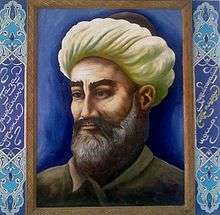Alisher Navoiy Secondary School (Isfana)
| Alisher Navoiy Secondary School Uzbek: Alisher Navoiy nomli oʻrta maktab, Алишер Навоий номли ўрта мактаб Kyrgyz: Алишер Навои атындаги орто мектеби Russian: Средняя школа имени Алишера Навои | |
|---|---|
| Location | |
|
Isfana Kyrgyzstan | |
| Coordinates | 39°50′17″N 69°32′45″E / 39.8380°N 69.5459°E |
| Information | |
| School type | Elementary, secondary, and high school |
| Religious affiliation(s) | None |
| Established | 1977 |
| Headmaster | Orozgul Sattarova |
| Language | Uzbek, Kyrgyz, and Russian |
|
The main entrance to Alisher Navoiy Secondary School | |
Alisher Navoiy Secondary School (Uzbek: Alisher Navoiy nomli oʻrta maktab, Алишер Навоий номли ўрта мактаб; Kyrgyz: Алишер Навои атындаги орто мектеби; Russian: Средняя школа имени Алишера Навои) is a secondary school in Isfana, Kyrgyzstan.[1] Although the school is called a secondary school, it offers classes for grades one through eleven. The school has Uzbek, Kyrgyz, and Russian classes.[2]
The school was established in 1977 on the occasion of the 60th anniversary of the October Revolution and was therefore initially called the 60th Anniversary of the October Revolution (Uzbek: Oktabr 60 yilligi, Октябрь 60 йиллиги; Kyrgyz: Октябрь 60 жылдыгы; Russian: 60 лет Октября). After Kyrgyzstan became independent in 1991, the school was renamed Alisher Navoiy Secondary School in honor of the great Turkic poet and statesman Ali-Shir Nava'i.
General framework and curriculum
At Alisher Navoiy Secondary School, children are accepted to first grade at the age of six or seven, depending on the child's individual development. The eleven-year school term is split into elementary (grades 1-4), middle (grades 5-9) and senior (grades 10-11) classes. Attending a "basic" nine-year (elementary and middle) program is compulsory. Grades 10-11 are optional.
As in many parts of the country, at Alisher Navoiy Secondary School children of elementary classes are normally separated from other classes within their own floor of the school building. They are taught, ideally, by a single teacher through all four elementary grades (except for physical education and foreign languages).
Starting from the fifth grade, each academic subject is taught by a dedicated specialty teacher. The school curriculum for senior students includes subjects like mathematics, informatics, physics, chemistry, geography, biology, arts, music, physical education, history, and astronomy. English is taught as a foreign language starting from the fifth grade.
Like many other schools in Kyrgyzstan, Alisher Navoiy Secondary School is a double shift school where two streams of students (morning shift and evening shift) share the same facility. The reason for this is that school capacity is insufficient to teach all of the students on a normal, morning-to-afternoon, schedule.
The school year extends from the beginning of September to the end of May and is divided into four terms. The school curriculum at Alisher Navoiy Secondary School is fixed: unlike in some Western countries, schoolchildren cannot choose what subjects to study. Students are graded on a five-step scale, ranging in practice from 2 ("unacceptable") to 5 ("excellent"); 1 is a rarely used sign of extreme failure. Teachers regularly subdivide these grades (i.e. 4+, 5-) in daily use, but term and year results are graded strictly 2, 3, 4, or 5.
Medium of instruction

There are Uzbek, Kyrgyz, and Russian classes at the school.[3] Like in many other Kyrgyzstani schools with Uzbek-language classes, the future of teaching in Uzbek remains uncertain at Alisher Navoiy Secondary School.[4]
Lately Kyrgyz authorities have been taking measures to remove the Uzbek language from public life and have been pushing to forcibly switch Uzbek schools to Kyrgyz.[5][6][7][8][9] There are not enough school textbooks in Uzbek and the Kyrgyz government is unwilling provide them, claiming that it does not have enough funds. As Kyrgyz officials strongly oppose the use of textbooks printed in Uzbekistan, currently the majority of Uzbek schoolchildren in Kyrgyzstan study in Uzbek using Kyrgyz textbooks. In addition, in the early 2010s the number of teaching hours allocated to Kyrgyz language and literature lessons at Uzbek schools has been significantly increased at the expense of Uzbek language and literature lessons.[10]
In 2012, local Kyrgyz officials forced the school administration to remove a portrait of Ali-Shir Nava'i, a national hero for Uzbeks, from the lobby of the school. There have also been attempts to rename the school on many occasions, but none has succeeded so far.
References
- ↑ "Isfana: City profile". The Association of Municipalities of the Kyrgyz Republic. Retrieved 27 October 2014.
- ↑ "Alisher Navoiy Secondary School". The official website of Isfana (in Russian). Retrieved 30 January 2012.
- ↑ "Photo - The Most Multinational School in Isfana". Turmush (in Russian). 29 November 2016. Retrieved 29 November 2016.
- ↑ Usmon, Sarvar (11 October 2011). "The fate of Uzbek-language schools in Kyrgyzstan is uncertain". RFE/RL's Uzbek Service (in Uzbek). Retrieved 30 October 2012.
- ↑ Sherzod (19 November 2011). "What's the purpose? Increasing illiteracy?". RFE/RL's Uzbek Service (in Uzbek). Retrieved 30 October 2012.
- ↑ Ibraimov, Bakyt; Temir Akmatov (8 December 2011). "Osh mulls ban on Uzbek-language schools". Transitions Online. Retrieved 22 February 2012.
- ↑ Ibraimov, Bakyt; Temir Akmatov (6 August 2012). "Tough talk on Kyrgyz schools". TOL Chalkboard. Retrieved 28 October 2014.
- ↑ Kasym, Elmurad (26 September 2012). "Removing Uzbek from public life". Registan. Retrieved 9 October 2012.
- ↑ Wisniewski, Dan (1 October 2012). "Uzbek language disappearing in Kyrgyzstan". RFE/RL. Retrieved 9 October 2012.
- ↑ Ivashenko, Yekaterina (13 February 2013). "Who needs this Uzbek education". Fergana News (in Russian). Retrieved 15 April 2014.
External links
| Wikimedia Commons has media related to Alisher Navoiy Secondary School. |